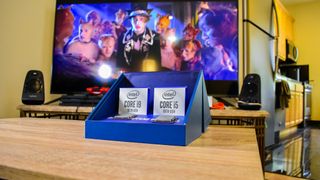Intel finally reveals Comet Lake power usage when CPUs hit max boost
We now have official figures for Comet Lake power usage at flat-out 'PL2' speeds

Intel has released the full details of the power usage of its new Comet Lake 10th-gen desktop processors, letting us know the official ratings for CPU power consumption when pushed to the maximum boost speeds – which are very different to the base clock speeds (with no Turbo active).
It’s a bit of a jargon attack, but the power draw at stock clock speeds is known as ‘PL1’ (Power Level 1) and this was the only info Intel released when its 10th-gen processors launched, leaving some folks disgruntled that they weren’t being informed of the full spec and power usage when boost kicks in.
- Best gaming laptops of 2020
- We’ve picked out all the best processors
- Check out how to overclock your CPU
At any rate, thanks to German tech site ComputerBase, we now know the spec for Comet Lake chips in terms of the ‘PL2’ figure, which is the max power draw the CPU can hit running flat-out at top boost speed.
Taking the flagship Core i9-10900K as an example, the PL1 or base power consumption is rated at 125W, but the PL2 is 250W – so it can use twice as much power when boosting to the max compared to when trundling along at the base clock speed.
This isn’t a huge surprise, as the predecessor Core i9-9900K was rated at 95W for PL1, and hit around 160W to 180W in actual usage (as Extremetech found at the time), so close to double. But Comet Lake pushes this boost power usage further still, and the range of power consumption in actual real-world use, going by Der8auer’s test results on 30 of Intel’s 10900K flagship CPUs (as spotted by Videocardz) ranges from 232W to 278W.
As for the Core i7-10700K and Core i5-10600K, these processors are again rated at 125W for PL1, but 229W and 182W respectively for PL2.
Tau tales
Intel also disclosed the Tau values for its new 10th-gen chips, which is the length of time that a processor is allowed to run at maximum performance or PL2, before it’s cut back to PL1 stock speeds. The 10900K, 10700K and 10600K all have a Tau of 56 seconds.
Get daily insight, inspiration and deals in your inbox
Get the hottest deals available in your inbox plus news, reviews, opinion, analysis and more from the TechRadar team.
Remember, however, that what motherboard you run also has an effect on the Comet Lake CPU nestling in it, because board manufacturers can configure their own PL2 and Tau settings based on the quality and capabilities of the motherboard (although pushing too hard on this front could, of course, affect the overall stability of the system).
When it comes to the low-power Core i9-10900T (10-core CPU), that model has a PL1 of just 35W, but the PL2 is much higher at 123W – that’s 3.5x higher, in fact; much more than the doubling of the 10900K.
- See all the best gaming PCs of 2020
Darren is a freelancer writing news and features for TechRadar (and occasionally T3) across a broad range of computing topics including CPUs, GPUs, various other hardware, VPNs, antivirus and more. He has written about tech for the best part of three decades, and writes books in his spare time (his debut novel - 'I Know What You Did Last Supper' - was published by Hachette UK in 2013).
